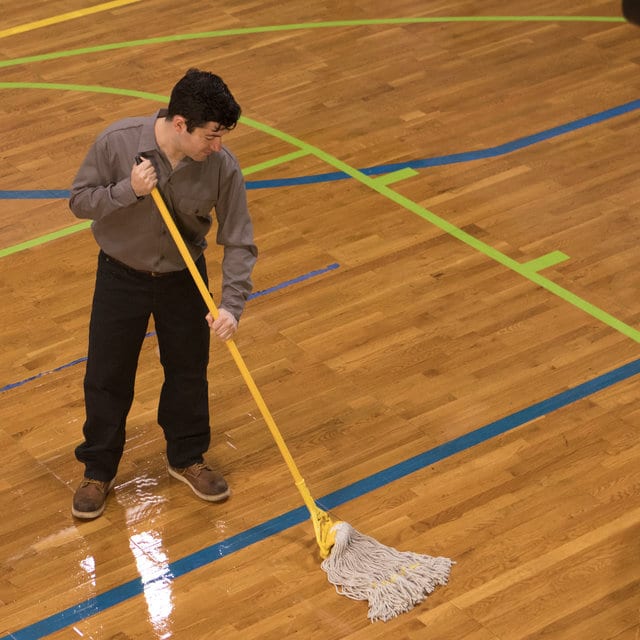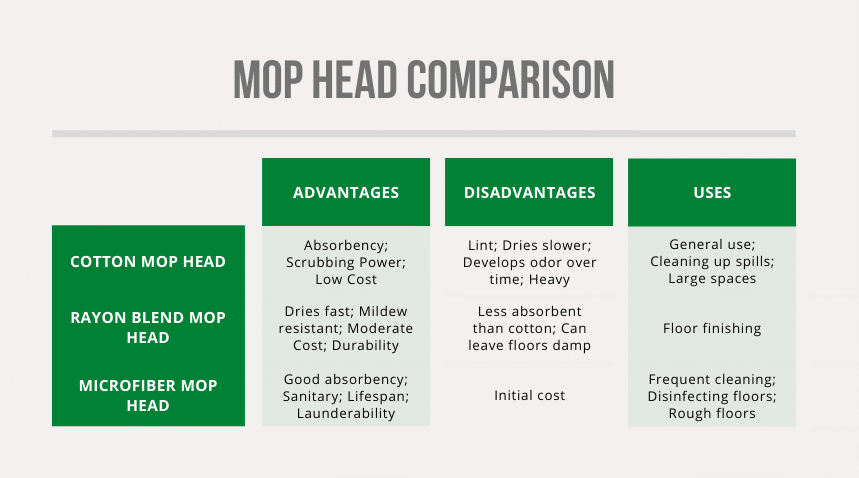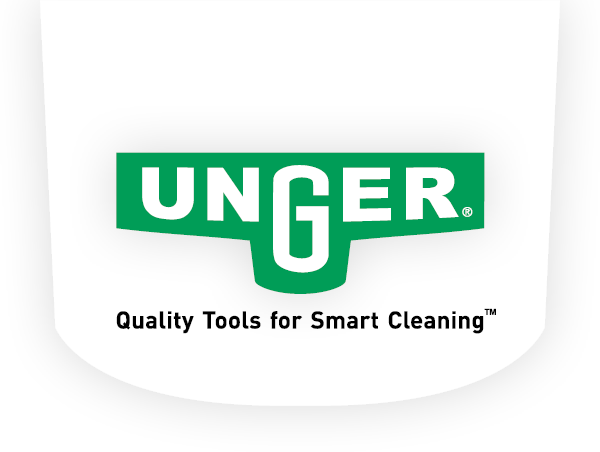NEW! Powerful Nano Filtration with Unger's HydroPower® Nano See The Product

Selecting the Best Commercial Mop Head for Your Floor Cleaning Needs
One size certainly does not fit all when it comes to the mopping system you use for your floor cleaning and maintenance tasks. That thought holds true all the way down to one of the smallest, yet also one of the most important components – the mop head. Different mop heads are created to tackle specific jobs in your facility to help janitorial staff achieve the best results. There’s not really such a thing as a bad mop head, as each one serves its purpose for a particular application, but given all of the available commercial mop head options on the market, you can easily make errors in choosing the best one for your task at hand.
To consistently get the results you want from your floor cleaning and maintenance efforts, we recommend getting to know your mop head options better, including the purchasing considerations, so that you can choose the right one for the job!
Types of Floor Cleaning Mop Heads
At the most basic level, you have the traditional cotton string mop, microfiber mop head, and rayon blend mop, all of which have their benefits when used appropriately:
Cotton String Mop Heads
Cotton mops have long been heralded as the workhorse of mop heads given their absorbency and scrubbing power. You can also typically find them in wider sizes than other types of mops, making them ideal for large spaces where you need to cover more ground.
The challenge, however, is that cotton mops do not dry quickly as with other materials, and so they can quickly develop an unpleasant odor. Thankfully they are a more affordable option than microfiber and can be easily disposed of rather than laundered.
Cotton string mops are also 80% heavier than microfiber, putting a higher amount of strain on the worker’s body, especially given the repetitiveness of the task.
Rayon Blend Mop Head
While these mop heads don’t offer the same superior absorbency of its cotton counterpart, the upside is that this blended yarn is more bleach and mildew resistant and less likely to create an odor. It’s also more durable than cotton given it’s made with 100% long staple synthetic fibers, which contribute to the fact that rayon produces less lint than cotton.
The downside is that since rayon blend mops cannot absorb as much liquid as a cotton mop head, they can leave floors slightly damp which can lead to costly slip and fall accidents.
Microfiber Mop Head
Comparing microfiber mops to cotton and other synthetic options, microfiber is easier to keep clean and is overall, a more sanitary option given that the material can withstand repetitive laundering without degrading. Whereas cotton can last around 15-30 washes, microfiber mop can maintain their integrity for 150-200 washes.
According to a study published by the American Journal of Infection Control, microfiber mops also remove far more microbes than standard cotton string mops. This finding amounted to a difference of 95% removed microbes with standard detergent using a microfiber mop, while only 68% of microbes were removed with standard detergent and a cotton string mop. Like microfiber cloths, the technology and ease of use will produce a cleaner, healthier facility when used as part of your floor cleaning system and/or restroom cleaning system.
One thing to note on microfiber is that cotton holds up better when bleach or acidic chemicals are required for floor cleaning. These products can break down microfiber.

Selecting a Cleaning Mop Head
Upfront planning before purchasing a commercial floor mopping system will pay off in the form of effective cleaning and tool longevity. Following are considerations to evaluate when selecting the cleaning mop head that’s right for your application:
Yarn Ply: Ply refers to the number of fibers twisted together to form a single yarn strand. Typically the more plies means more strength, but while it adds durability, it also decreases absorbency. In general, we recommend choosing a low ply, higher quality yarn rather than a high ply, low quality yarn.
Headbands: Headbands determine how the mop head attaches to the mop handle and there are two main types: narrow headbands and wide Narrow bands measure 1” – 1 1⁄4” wide and attach to quick-release handles. Wide bands are 5” inch headbands attach to jaw-style handles that tightly grip the mop head, making for a more durable mop. Plus you can source a mop head that features a scrub pad material on the headband to help remove stubborn scuffs and spots.
Absorbency and Size: Absorbency refers to the amount of liquid the mop can pick up and hold. The greater the absorbency, the faster the mop head can clean up liquids and the faster floors can begin to dry. It’s important to note that the absorbency does depend solely on the mop material, but also on the size. In general:
Small mop heads hold 8 – 10 oz. of liquid
Medium mop heads hold 16 – 20 oz. of liquid
Large mop heads hold 24 – 32 oz. of liquid
Extra-Large mop heads hold 32 – 40 oz. of liquid
Release: How well the mop disperses water or cleaning solution during wringing is what is referred to as the release. With a greater release, you get a more thorough wringing, which will increase the efficiency and effectiveness of the floor cleaning process.
Durability and Launderability: Both of these characteristics will determine the lifespan of a commercial mop head. Mops have to be discarded and replaced for a variety of reasons including fibers degradation, odor, bacteria growth and unsightly discoloration. The type of yarn will help establish durability, but how it stands up to the laundering process will as well. Launderability describes a mop head’s ability to withstand washing in a commercial machine. The better the launderability, the more wash cycles it can successfully endure before you start to see either a breakdown in the material or its ability to effectively perform the job. Materials with the highest launderability are microfiber, synthetic, blend, and rayon.
Cleaning Application: Different surfaces and jobs call for different mop heads – remember, one size does not fit all. For example, cotton is a good low-cost choice for general cleaning, such as for spill cleanup. If you need a finish mop, you’ll want to source a mop with sufficient absorbency and release to efficiently and evenly spread finishing solutions. And for disinfecting floor surfaces, you’ll want a material with adequate release, chemical resistance, and launderability.
Efficient, Effective Floor Cleaning Starts with the Right Commercial Mop Head
Mop heads are only a single component of what you need to consider when selecting a floor mopping or finishing system. Commercial cleaning tool manufacturers look for ways to elevate their tools to meet the needs of facilities and those people performing the job, and while a mop head may seem like a small component, it’s invaluable when it comes to the efficiency of performing the job. Explore Unger’s portfolio of floor mopping and floor finishing kits or contact us to discuss your facility’s needs.
If you would like assistance in evaluating your current floor care equipment and learning more about the innovative commercial mop heads from Unger, please contact us.
